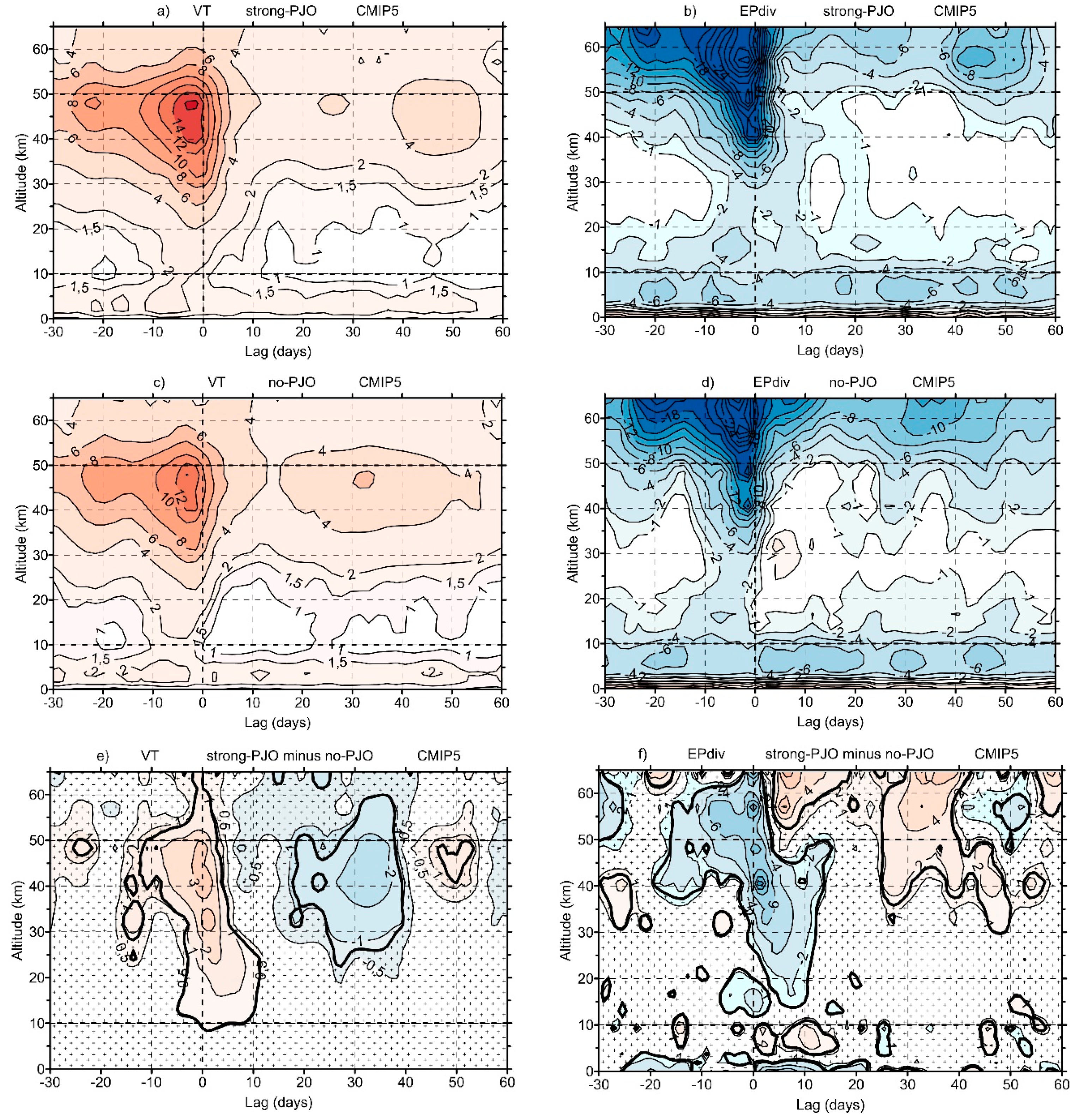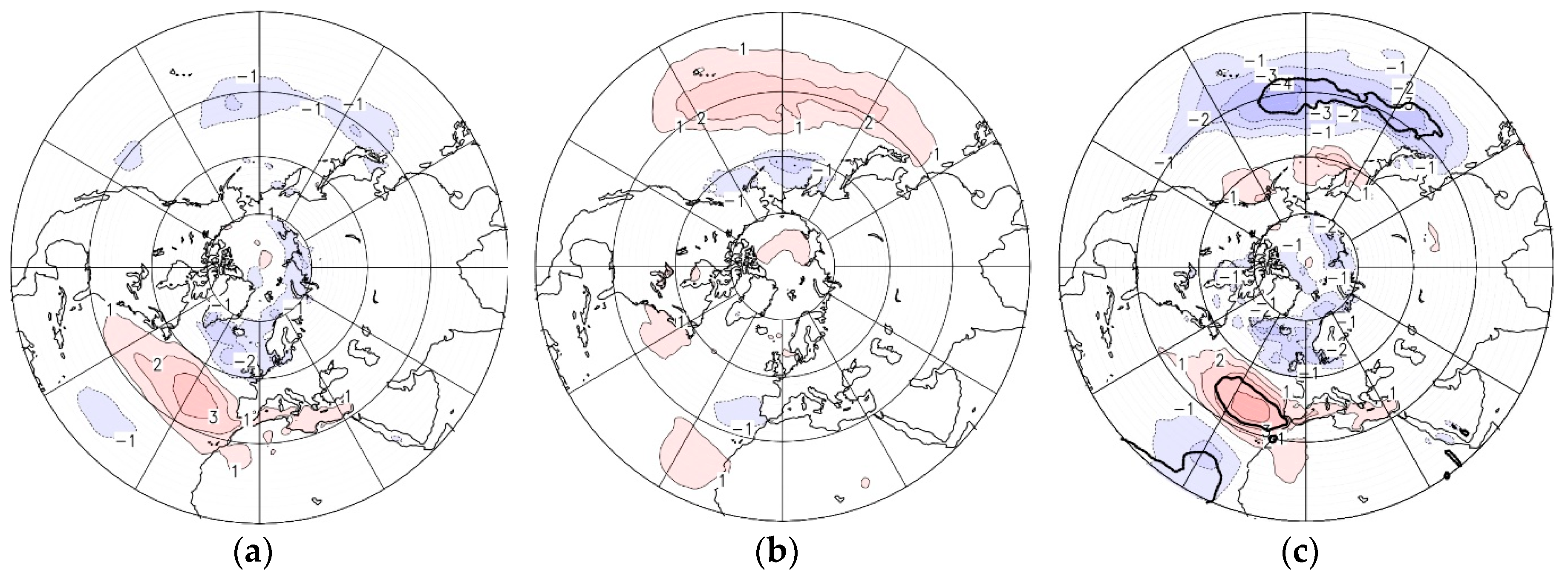Enhanced Stratosphere/Troposphere Coupling During Extreme Warm Stratospheric Events with Strong Polar-Night Jet Oscillation
Abstract
:1. Introduction
2. Data Sets and Methodology
3. Results
3.1. Zonally Symmetric Structure: Evolution
3.2. Zonally Asymmetric Structure—Era-Interim
4. Discussion
5. Conclusions
Supplementary Materials
Author Contributions
Funding
Acknowledgments
Conflicts of Interest
References
- Polvani, L.M.; Waugh, D.W. Upward wave activity flux as a precursor to extreme stratospheric events and subsequent anomalous surface weather regimes. J. Clim. 2004, 17, 3548–3554. [Google Scholar] [CrossRef]
- Andrews, D.G.; Holton, J.R.; Leovy, C.B. Middle Atmosphere Dynamics, 1st ed.; Academic Press: New York, NY, USA, 1987; Volume 40, ISBN 9780120585762. [Google Scholar]
- Baldwin, M.P.; Dunkerton, T.J. Propagation of the Arctic oscillation from the stratosphere to the troposphere. J. Geophys. Res. 1999, 104, 30937–30946. [Google Scholar] [CrossRef]
- Baldwin, M.P.; Dunkerton, T.J. Stratospheric harbingers of anomalous weather regimes. Science 2001, 294, 581–584. [Google Scholar] [CrossRef] [PubMed]
- Butler, A.H.; Sjoberg, J.P.; Seidel, D.J.; Rosenlof, K.H. A sudden stratospheric warming compendium. Earth Syst. Sci. Data 2017, 9, 63–76. [Google Scholar] [CrossRef] [Green Version]
- Kobayashi, S.; Ota, Y.; Harada, Y.; Ebita, A.; Moriya, M.; Onoda, H.; Onogi, K.; Kamahori, H.; Kobayashi, C.; Endo, H.; et al. The JRA-55 Reanalysis: General Specifications and Basic Characteristics. JMSJ 2015, 93, 5–48. [Google Scholar] [CrossRef] [Green Version]
- Baldwin, M.P.; Stephenson, D.B.; Thompson, D.W.J.; Dunkerton, T.J.; Charlton, A.J.; O’Neill, A. Stratospheric memory and skill of extended-range weather forecasts. Science 2003, 301, 636–640. [Google Scholar] [CrossRef] [PubMed]
- Sigmond, M.; Scinocca, J.F.; Kharin, V.V.; Shepherd, T.G. Enhanced seasonal forecast skill following stratospheric sudden warmings. Nat. Geosci. 2013, 6, 98–102. [Google Scholar] [CrossRef]
- Peters, D.H.W.; Schneidereit, A.; Bügelmayer, M.; Zülicke, C.; Kirchner, I. Atmospheric circulation changes in response to an observed stratospheric zonal ozone anomaly. Atmos. Ocean 2015, 53, 74–88. [Google Scholar] [CrossRef]
- Tripathi, O.P.; Charlton-Perez, A.; Sigmond, M.; Vitaret, F. Enhanced long-range forecast skill in boreal winter following stratospheric strong vortex conditions. Environ. Res. Lett. 2015, 10, 104007. [Google Scholar] [CrossRef] [Green Version]
- Karpechko, A.Y.; Hitchcock, P.; Peters, D.H.W.; Schneidereit, A. Predictability of downward propagation of major sudden stratospheric warmings. Q. J. R. Meteorol. Soc. 2017, 143, 1459–1470. [Google Scholar] [CrossRef]
- White, I.; Garfinkel, C.; Gerber, E.; Jucker, M.; Aquila, V.; Oman, L. The Downward Influence of Sudden Stratospheric Warmings: Association with Tropospheric Precursors. J. Clim. 2018. [Google Scholar] [CrossRef]
- Holton, J.R.; Mass, C. Stratospheric vacillation cycles. J. Atmos. Sci. 1976, 33, 2218–2225. [Google Scholar] [CrossRef]
- Kuroda, Y.; Kodera, K. Role of the Polar-night Jet Oscillation on the formation of the Arctic Oscillation in the Northern Hemisphere in winter. J. Geophys. Res. 2004, 109, D11112. [Google Scholar] [CrossRef]
- Hitchcock, P.; Shepherd, T.G.; Manney, G.L. Statistical characterization of Arctic polar-night jet oscillation events. J. Clim. 2013, 26, 2096–2116. [Google Scholar] [CrossRef]
- Hitchcock, P.; Simpson, I.R. The downward influence of stratospheric sudden warmings. J. Atmos. Sci. 2014, 71, 3856–3876. [Google Scholar] [CrossRef]
- Maycock, A.C.; Hitchcock, P. Do split and displacement sudden stratospheric warmings have different annular mode signatures? Geophys. Res. Lett. 2015, 42, 10910–943951. [Google Scholar] [CrossRef]
- Runde, T.; Dameris, M.; Garny, H.; Kinnison, D.E. Classification of stratospheric extreme events according to their downward propagation to the troposphere. Geophys. Res. Lett. 2016, 43, 6665–6672. [Google Scholar] [CrossRef]
- Peters, D. Zur resonanten Wechselwirkung von planetaren Wellen in einem Zweischichtenmodell unter Berücksichtigung der externen Anregung einer Welle; Teil 1: Der Amplitudenverlauf. Z. Meteorol. 1985, 35, 239–251. [Google Scholar]
- Peters, D. Zur resonanten Wechselwirkung von planetaren Wellen in einem Zweischichtenmodell unter Berücksichtigung der externen Anregung einer Welle; Teil 2: Die zonal gemittelte Bewegung. Z. Meteorol. 1985, 35, 252–256. [Google Scholar]
- Palmer, T.N.; Hsu, C.-P.F. Stratospheric sudden coolings and the role of nonlinear wave interactions in preconditioning the circumpolar flow. J. Atmos. Sci. 1983, 40, 909–928. [Google Scholar] [CrossRef]
- Perlwitz, J.; Harnik, N. Downward coupling between the stratosphere and troposphere: The relative roles of wave and zonal mean processes. J. Clim. 2004, 17, 4902–4909. [Google Scholar] [CrossRef]
- Kodera, K.; Mukougawa, H.; Maury, P.; Ueda, M.; Claud, C. Absorbing and reflecting sudden stratospheric warming events and their relationship with tropospheric circulation. J. Geophys. Res. Atmos. 2016, 121, 80–94. [Google Scholar] [CrossRef] [Green Version]
- Manney, G.L.; Sabutis, J.L.; Allen, D.R.; Lahoz, W.A.; Scaife, A.A.; Randall, C.E.; Pawson, S.; Naujokat, B.; Swinbank, R. Simulations of dynamics and transport during the September 2002 Antarctic major warming. J. Atmos. Sci. 2005, 62, 690–707. [Google Scholar] [CrossRef]
- Kuroda, Y.; Kodera, K. Variability of the polar-night jet in the Northern and Southern Hemispheres. J. Geophys. Res. 2001, 106, 20703–20713. [Google Scholar] [CrossRef]
- Christiansen, B. Downward propagation of zonal mean zonal wind anomalies from the stratosphere to the troposphere: Model and reanalysis. J. Geophys. Res. 2001, 106, 27307–27322. [Google Scholar] [CrossRef] [Green Version]
- Charlton, A.J.; Polvani, L.M. A new look at stratospheric sudden warmings. Part I: Climatology and modeling benchmarks. J. Clim. 2007, 20, 449–469. [Google Scholar] [CrossRef]
- Hitchcock, P.; Shepherd, T.G. Zonal mean dynamics of extended recoveries from stratospheric sudden warmings. J. Atmos. Sci. 2013, 70, 688–707. [Google Scholar] [CrossRef]
- Simpson, I.R.; Hitchcock, P.; Seager, R.; Wu, Y.; Callaghan, P. The downward influence of uncertainty in the Northern Hemisphere stratospheric polar vortex response to climate change. J. Clim 2018, 31, 6371–6391. [Google Scholar] [CrossRef]
- Hitchcock, P.; Simpson, I.R. Quantifying eddy feedbacks and forcings in the tropospheric response to stratospheric sudden warmings. J. Atmos. Sci. 2016, 73, 3641–3657. [Google Scholar] [CrossRef]
- Peters, D.H.W.; Waugh, D.W. Influence of barotropic shear on the poleward advection of upper-tropospheric air. J. Atmos. Sci. 1996, 53, 3013–3031. [Google Scholar] [CrossRef]
- Dee, D.P.; Uppala, S.M.; Simmons, A.J.; Berrisford, P.; Poli, P.; Kobayashi, S.; Andrae, U.; Balmaseda, M.A.; Balsamo, G.; Bauer, P.; et al. The ERA-Interim reanalysis: Configuration and performance of the data assimilation system. Q. J. R. Meteorol. Soc. 2011, 137, 553–597. [Google Scholar] [CrossRef]
- Giorgetta, M.A.; Jungclaus, J.; Reick, C.H.; Legutke, S.; Bader, J.; Böttinger, M.; Brovkin, V.; Crueger, T.; Esch, M.; Fieg, K.; et al. Climate and carbon cycle changes from 1850 to 2100 in MPI-ESM simulations for the Coupled Model Intercomparison Project phase 5. J. Adv. Model. Earth Syst. 2013, 5, 572–597. [Google Scholar] [CrossRef] [Green Version]
- Schulzweida, U. Climate Data Operators (CDO) User Guide, Version 1.9.3; Max Planck Institute for Meteorology: Hamburg, Germany, 2018; Available online: https://code.mpimet.mpg.de/projects/cdo/embedded/cdo.pdf (accessed on 1 February 2018).
- Siegmund, P. Stratospheric polar cap mean height and temperature as extended-range weather predictors. Mon. Weather Rev. 2005, 133, 2436–2448. [Google Scholar] [CrossRef]
- Baldwin, M.P.; Thompson, D.W.J. A critical comparison of stratosphere -troposphere coupling indices. Q. J. R. Meteorol. Soc. 2009, 135, 1661–1672. [Google Scholar] [CrossRef]
- Taubenheim, J. Statistische Auswertung Geophysikalischer und Meteorologischer Daten; [Statistical Analysis of Geophysical and Meteorological Data]; Geest & Portig: Leipzig, Germany, 1969. [Google Scholar]
- Dunkerton, T.; Hsu, C.-P.F.; McIntyre, M.E. Some Eulerian and Langrangian diagnostics for a model stratospheric warmings. J. Atmos. Sci. 1981, 38, 819–844. [Google Scholar] [CrossRef]
- de la Càamara, A.; Abalos, M.; Hitchcock, P. Changes in stratospheric transport and mixing during sudden stratospheric warmings. J. Geophys. Res. 2018, 123, 3356–3373. [Google Scholar] [CrossRef]
- Calvo, N.; Polvani, L.M.; Solomon, S. On the surface impact of Arctic stratospheric ozone extremes. Environ. Res. Lett. 2015, 10, 094003. [Google Scholar] [CrossRef] [Green Version]
- Ivy, D.J.; Solomon, S.; Calvo, N.; Thompson, D.W.J. Observed connections of Arctic stratospheric ozone extremes to Northern Hemisphere surface climate. Environ. Res. Lett. 2017, 12, 024004. [Google Scholar] [CrossRef] [Green Version]
- Gabriel, A.; Peters, D. A diagnostic study of Rossby wave breaking events in the northern extra-tropics. JMSJ 2008, 86, 613–631. [Google Scholar] [CrossRef]
- Takaya, K.; Nakamura, H. A formulation of a wave-activity flux for stationary Rossby waves on a zonally varying basic flow. Geophys. Res. Lett. 1997, 24, 2985–2988. [Google Scholar] [CrossRef] [Green Version]
- Ambaum, M.H.P.; Hoskins, B.J.; Stephenson, D.B. Arctic oscillation or North Atlantic oscillation? J. Clim. 2001, 14, 3495–3507. [Google Scholar] [CrossRef]
- Thompson, D.W.J.; Wallace, J.M. Annular modes in the extratropical circulation. Part I: Month-to-month variability. J. Clim. 2000, 13, 1000–1016. [Google Scholar] [CrossRef]











© 2018 by the authors. Licensee MDPI, Basel, Switzerland. This article is an open access article distributed under the terms and conditions of the Creative Commons Attribution (CC BY) license (http://creativecommons.org/licenses/by/4.0/).
Share and Cite
Peters, D.H.W.; Schneidereit, A.; Karpechko, A.Y. Enhanced Stratosphere/Troposphere Coupling During Extreme Warm Stratospheric Events with Strong Polar-Night Jet Oscillation. Atmosphere 2018, 9, 467. https://doi.org/10.3390/atmos9120467
Peters DHW, Schneidereit A, Karpechko AY. Enhanced Stratosphere/Troposphere Coupling During Extreme Warm Stratospheric Events with Strong Polar-Night Jet Oscillation. Atmosphere. 2018; 9(12):467. https://doi.org/10.3390/atmos9120467
Chicago/Turabian StylePeters, Dieter H.W., Andrea Schneidereit, and Alexey Y. Karpechko. 2018. "Enhanced Stratosphere/Troposphere Coupling During Extreme Warm Stratospheric Events with Strong Polar-Night Jet Oscillation" Atmosphere 9, no. 12: 467. https://doi.org/10.3390/atmos9120467
APA StylePeters, D. H. W., Schneidereit, A., & Karpechko, A. Y. (2018). Enhanced Stratosphere/Troposphere Coupling During Extreme Warm Stratospheric Events with Strong Polar-Night Jet Oscillation. Atmosphere, 9(12), 467. https://doi.org/10.3390/atmos9120467



